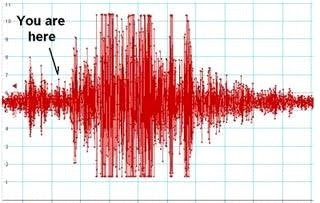Signs of an Approaching Decline in US Equities That Could Be Quite Impressive
 Courtesy of Jesse’s Café Américain
Courtesy of Jesse’s Café Américain
There is a strong correlation between this US equity rally and the Fed monetization of debt, which indicates a ‘hot money’ flow into US stocks but with thin volumes from a significant market bottom. This points to ‘technical price trading’ by the financial sector, also known as price manipulation, or trading stocks like commodities.
Continued heavy insider selling from those with the best forward view of the real economy is a clear sign of a top. No one can trust what the Fed or the Administration are saying about an economic recovery, as much now as ever. Obama’s administration is no reform government.
This surprisingly robust rally in US Treasuries is remarkable given the decline in the US dollar, based in part on a strong yen and carry trades. The short end is obviously quantitative easing, with strong buying from Asian central banks dumping Agency debt but continuing to manipulate their currencies. ‘Free trade’ is an illusion.
The long end rally in Treasury suspect is likely interest rate manipulation by the US Fed and its central bank cronies. It has been a huge mistake to allow the Fed to perform the non-traditional printing that young Ben touted so proudly in his famous essay. Clever in the short term is too often tragic overall.
Gold and silver are surging as investors largely outside the US seek safety in harder assets.
There is also a community of small speculators outside the US which has been buying stocks on dollar weakness, to play an arbitrage with their own currencies. There is a hot money crowd in eastern Europe for example, and in Asia. And so far this year it has been working. At some point that door will close, quite hard, and many will be caught offsides and out of luck.
A dollar devaluation? Technically one cannot officially devalue the dollar per se because it has no official peg. The more appropriate term is debasement perhaps, and de facto default, but the effect is the same; a decline in purchasing power by the dollar vis a vis other monetary instruments. But for now we are in a monetary matrix, and the central banks and their minions can continue to play their game.
Besides being the hallmark of markets made sick by central bank and other official manipulation, these are signs that indicate that the ‘smart money’ is battening down the hatches for a very rough September and October in US equities as the pros hand off their latest Ponzi scheme to the public.
We will not be surprised if there is a significant decline, first to a pullback of about 7 to 10 percent. Then we will see if the market can rally on renewed dollar devaluation and if not, then another major slide to test lower levels.
If there is an ‘event’ the pros will dump the market bids quite hard, perhaps precipitously. It is always easier to complete a market wash and rinse when a scapegoat is available.
Obviously no one can predict the future with certainty, and even within clearer trends the actual timeframes are always most difficult if barely possible when the markets are dominated by computer manipulation. But the auspices are ominous indeed, and we are proceeding with caution.
Until the banks are restrained, and the financial system is reformed, and the economy is brought back into balance, there can be no sustained US recovery.
CNN Money
Insiders sell like there’s no tomorrow
By Colin Barr, senior writer
September 11, 2009: 7:27 AM ET
Corporate officers and directors were buying stock when the market hit bottom. What does it say that they’re selling now?
NEW YORK (Fortune) — Can hundreds of stock-selling insiders be wrong?
The stock market has mounted an historic rally since it hit a low in March. The S&P 500 is up 55%, as U.S. job losses have slowed and credit markets have stabilized.
But against that improving backdrop, one indicator has turned distinctly bearish: Corporate officers and directors have been selling shares at a pace last seen just before the onset of the subprime malaise two years ago.
While a wave of insider selling doesn’t necessarily foretell a stock market downturn, it suggests that those with the first read on business trends don’t believe current stock prices are justified by economic fundamentals.
"It’s not a very complicated story," said Charles Biderman, who runs market research firm Trim Tabs. "Insiders know better than you and me. If prices are too high, they sell."
Biderman, who says there were $31 worth of insider stock sales in August for every $1 of insider buys, isn’t the only one who has taken note. Ben Silverman, director of research at the InsiderScore.com web site that tracks trading action, said insiders are selling at their most aggressive clip since the summer of 2007.
Silverman said the "orgy of selling" is noteworthy because corporate insiders were aggressive buyers of the market’s spring dip. The S&P 500 dropped as low as 666 in early March before the recent rally took it back above 1,000.
"That was a great call," Silverman said. "They were buying when prices were low, so it makes sense to look at what they’re doing now that prices are higher…"



